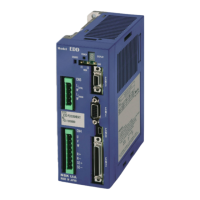11. Alarm and Warning
— 11-21 —
11.3.22. Warning P0: Over Heat
The warning P0 occurs when temperature of the heat sink of the Driver Unit or the external regeneration
resistor has exceeded the threshold.
This warning occurs when the continual current flow to the external regeneration resistor
elapsed over a period of 1 second due to excessive regeneration energy. (P0-1)
Table 11-31: Cause and remedy for the warning P0
Terminals SE+ and SE– of the
connector CN4 (Motor connector)
remain open even the external
regeneration resistor is not in use.
Short the terminal SE+ and SE– of the connector CN4 if the external
regeneration resistor is not used.
Ambient temperature of the Driver
Unit has exceeded 50[[°C]].
Confirm if the ambient temperature is less than 50[[°C]].
Review the environment the Driver unit is installed.
The power amplifier board has
applied the current to the Motor for
long enough to overheat its heat
sink exceeding 90[[°C]].
Check if excessive friction force is applied due to interference with the
surrounding mechanism or the Motor is locked.
Reduce the load moment of inertia.
Review the rate of operating time and idle time. (Increase idle time.)
Reduce the parameter settings of acceleration and deceleration.
In case of the pulse train command positioning, reduce those of the master
controller.
Lower the Motor velocity.
Excessive duty cycle of operation
Caused vibration due to poor tuning
of servo parameters.
Defective Cable, Motor or Driver
Unit
Check the Motor condition referring to “Appendix 2: How to Check Motor
Condition”. Replace the cable or the Motor if necessary.
If above measures do not work, the Driver Unit may be defective. Replace it
referring to “Appendix 5: Procedure for Replacing Driver Unit Model
EDD”.
(1) If the thermo sensor remains ON, the warning occurs again when the power is turned on.
11.3.23. Alarm P1: Main Power Overvoltage
The Driver Unit checks the voltage in the power amplifier and gives an alarm when it exceeds the specified
value.
Following are the cause of the increase in the voltage of power amplifier: the riding main power
voltage supplied externally and the rising voltage caused by the regeneration energy
Table 11-32: Cause and remedy for the alarm P1
Commutation voltage of the main power
has exceeded + 390 [V] (correspond to
input 275 [VAC] volts) due to the higher
voltage than the specification is applied.
Immediately shut down the main power.
Confirm the main power voltage and turn on the power again.
High moment of inertia of the load is
decelerated with extremely high
deceleration and resulted in the same
situation above.
Immediately shut off the main power.
Reduce the moment of inertia.
Reduce the settings of acceleration and deceleration.
Review the use of an external regeneration resistor. Refer to “Appendix 6:
Regeneration Resistor.”
Defective Cable, Motor or Driver Unit.
Check the Motor and the Cable referring to “Appendix 2: how to Check
Motor Condition” and replace them if necessary.
If the above measures do not work, the Driver Unit may be defective.
Replace it referring to “Appendix 5: Procedure for Replacing Driver Unit
Model EDD”.

